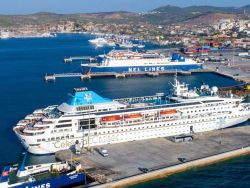Lavrio Port

Lavrio Port
Now, the mines have closed but Lavrio receives it livelihood from its port, which serves nearby and remote islands. While taking a wonderful drive along the coast that will lead you to Poseidon's Temple in Cape Sounio, within an hour and a half after leaving Athens, continue north for about 6 km. Here, you will find the small port of Lavrio and will have the opportunity to learn about its silver mines and archaeology. From this port, those of you with an extra day to spare should pop over on a ferry boat and visit the nearby Cycladic island of Kea. The harbor also serves the islands of Kythnos, Syros, Agios Efstrations, Psara, Limnos and Chios, and the city of Kavala in northern Greece. Lavrio deals with 5 kinds of sea traffic: coastal, leisure, commercial, cruise and fishing vessels.
The port of Lavrio has become a major attraction for many companies as the completion of the new modern port station and the port works, the close distance from the Athens International Airport "Eleftherios Venizelos" and the easy access to Attiki Odos along with the imminent extension of the urban railway have offered extrovertive characteristics aiming at the creation of additional facilities to the port and the economic development of the wider area.
Moreover, The Hellenic Republic Asset Development Fund (TAIPED) has announced that it is getting ready to create a "Mega-marina" next to the port of Lavrio. An overdue plan to extend the Hellenic Railway Organization’s (OSE) network from Koropi to the port of Lavrio in eastern Attica, and from the northern port of Kavala to nearby Toxotes, has now been officially scheduled following the approval of EU officials of a bid for the subsidization of the 2 projects. More specifically, representatives of the Trans-European Transport Network Executive Agency have given an initial ok to an application by OSE’s construction subsidiary, Ergose, for the 2 schemes, budgeted at a total of 5.6 million Euros, to be half-subsidized by European Union funding. The tenders for the 2 projects are expected to be issued shortly though it remained unclear how long it will take for them to come to fruition. The delay of urban railway's arrival to Lavrio is the only obstacle for shipping companies to operate in the specific port, decongesting the traffic in Piraeus port. Statistics have shown that 23 cruiseships docked at Lavrio carrying over 390,000 passengers in 2014.
Just recently, a new station for passenger ships operating on new technology was inaugurated at Lavrio harbor, at the southern tip of the Attica mainland. The bioclimatic station also includes 2 special finger-piers to accommodate ferries, and a laser-based system that allows the Port Authority to give directions to mooring ships when high winds prevail at nearly a 3 million Euros cost. The project was funded by the EU and Greek funds and answers to a greater project at the harbor. Pending projects at the location in question include the construction of a breakwater for small craft and a parking lot for cars, and the extension of the commercial sector to the south as well as the extension of the windward pier. The latter are scheduled to be completed in 2 years at a cost of over 42 million Euros.
More specifically, ferry boats from Lavrio go to the nearby island of Kea and the Cycladic island of Kythnos, but also serve legendary Makronissos and remote Eastern Aegean islands, in particular Lemnos and Agios Efstratios.










